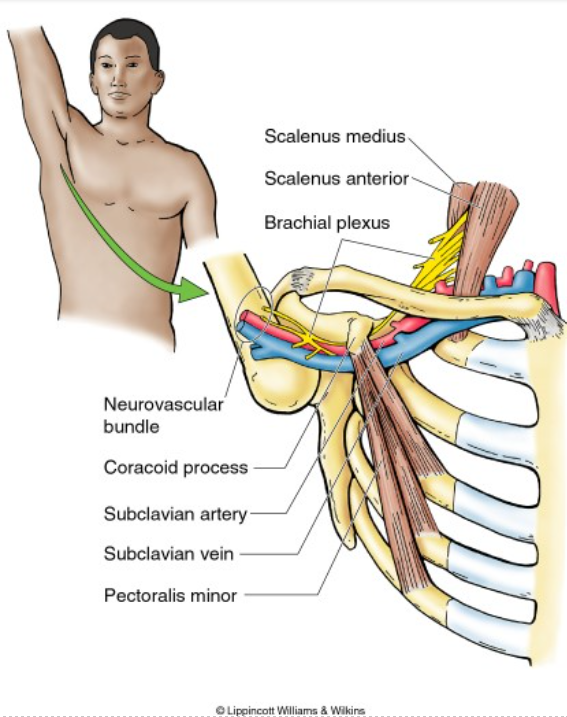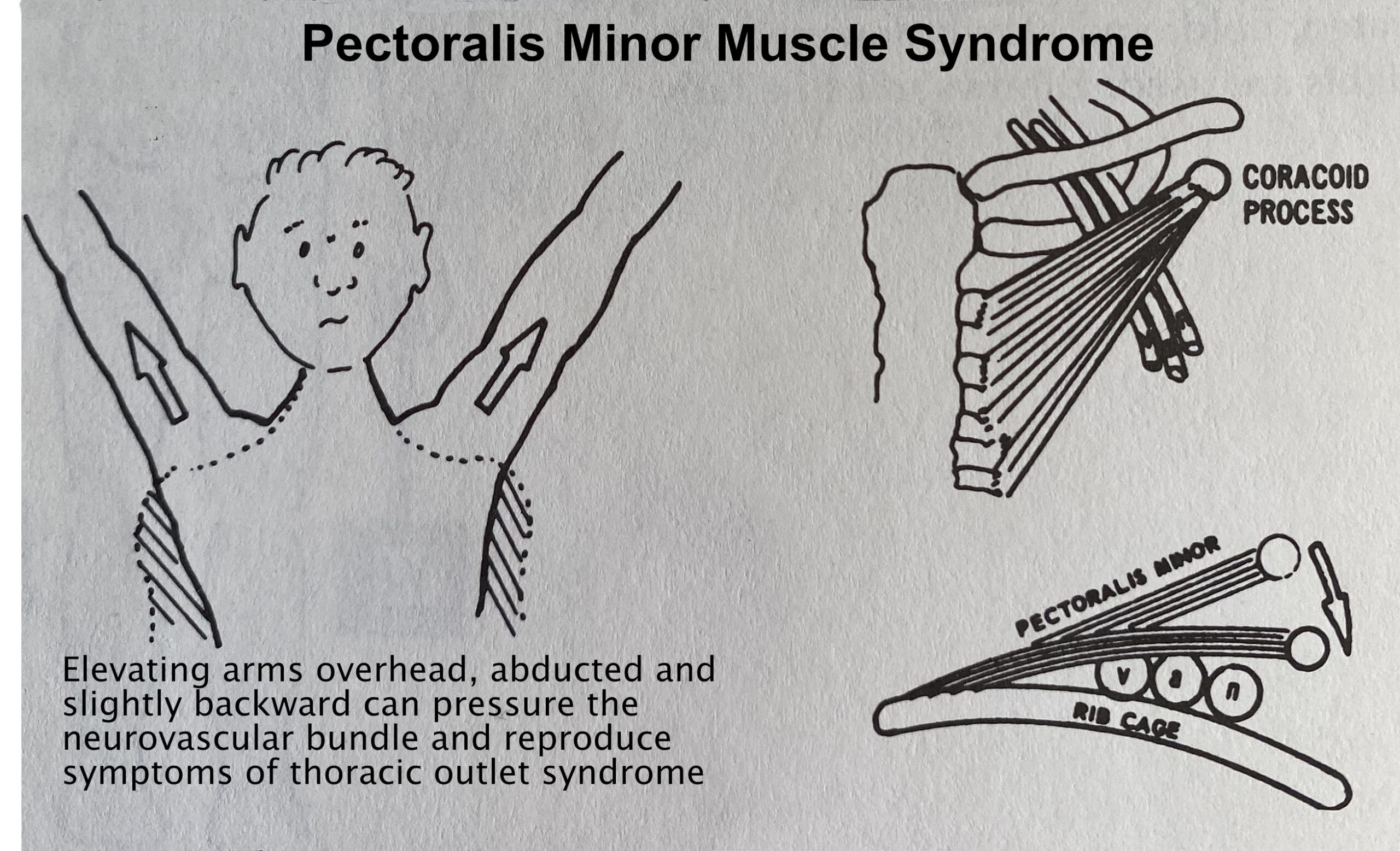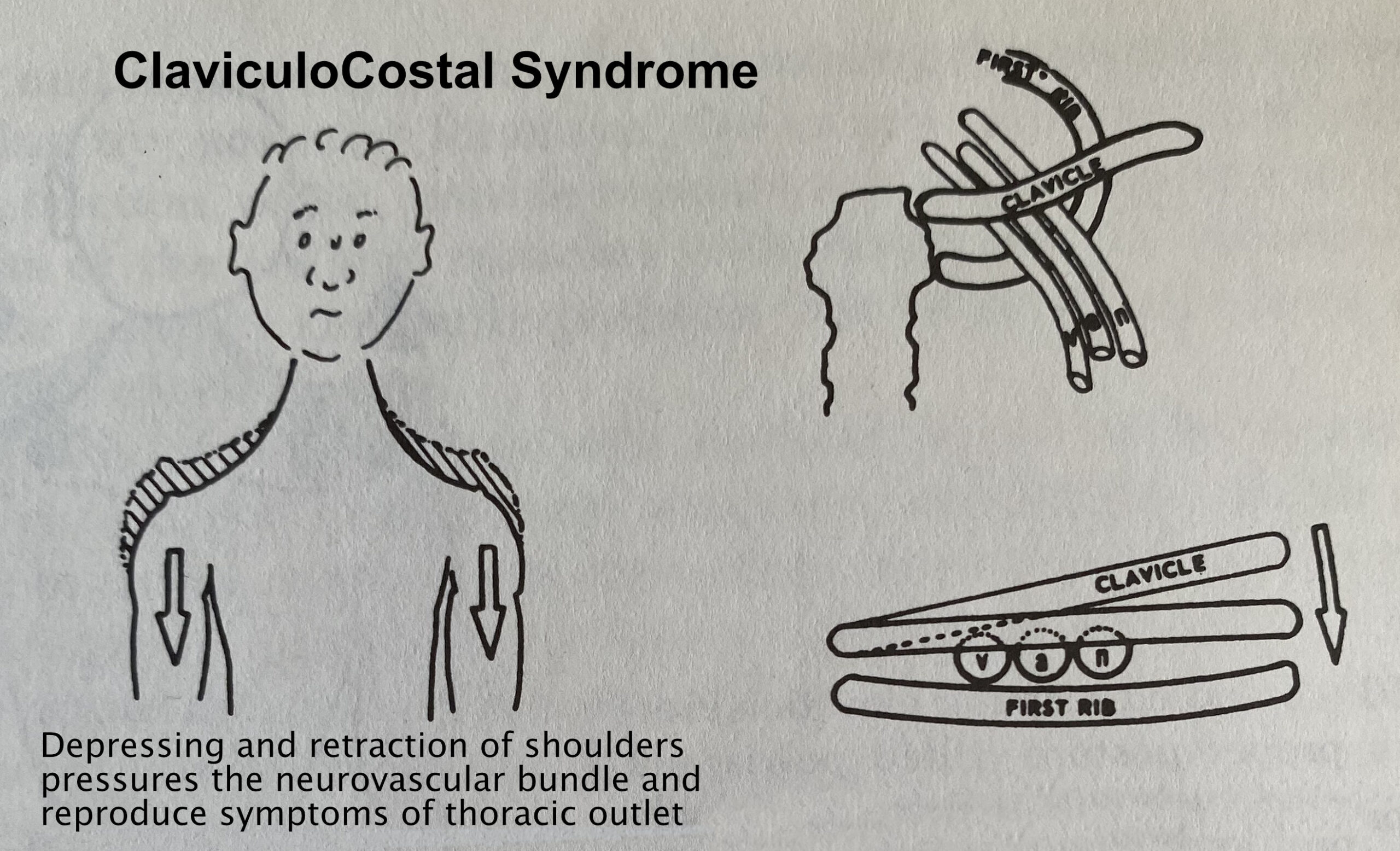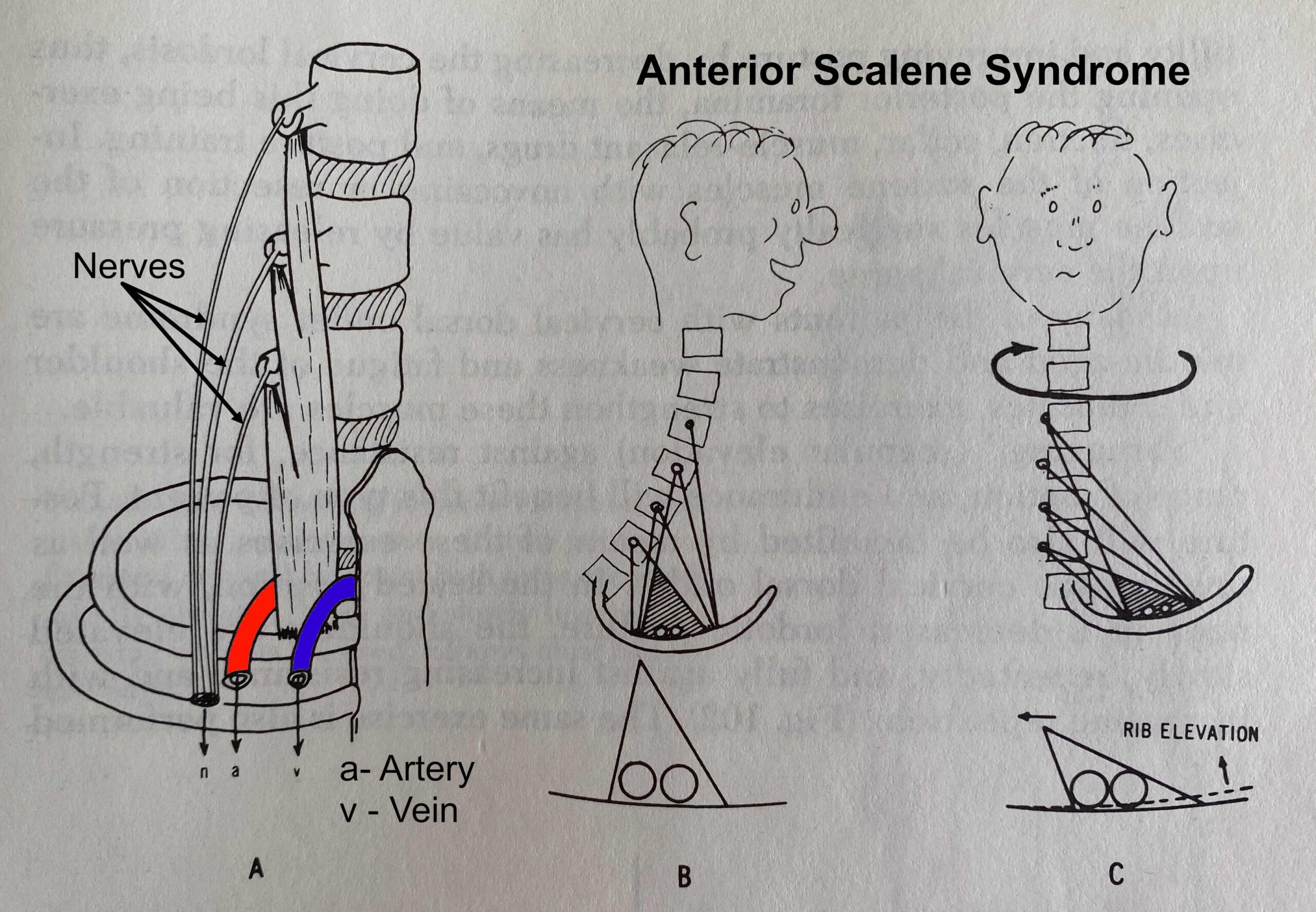Thoracic Outlet Syndrome
Thoracic Outlet Syndrome (TOS) is a disorder in which the nerves or blood vessels from the neck into the arm, the brachial plexus, are compressed.
Pain, numbness or “pins and needles” can occur from the neck and shoulders down the arm to the hands and fingers.
Chiropractors are experienced at treating thoracic outlet syndrome and are taught to identify which muscles, bones or joints can be causing the compression. This makes chiropractic manipulation and massage techniques an excellent choice of treatment.
Because both nerves and blood vessels may be compressed, there can be a variety of signs and symptoms. Females are far more likely to be diagnosed with TOS than males, and TOS is more common in young adults, between 20 and 40 years old.

Types of Thoracic Outlet Syndrome
Neurogenic or neurological Thoracic Outlet Syndrome
Compression of the brachial plexus, the network of nerves that come from your spinal cord and control muscle movements and sensation in your shoulder, arm and hand.
Symptoms of Neurogenic Thoracic Outlet Syndrome
Neurogenic TOS puts pressure on the brachial nerves, causing:
- Neck, shoulder or hand pains.
- Numbness or paraesthesia in the hand is very common, mainly the little finger more than the thumb, also in the forearm.
- Nocturnal numbness, especially on the ulnar side, with the arm swollen.
- Overhead activities, carrying loads, or while driving can commonly bring on the symptoms. Weakness of the shoulder, arm, hand, thumb or grip strength is common.
- Loss of fine motor skills.
Vascular Thoracic Outlet Syndrome
The veins or arteries under the clavicle are compressed.
Symptoms of Vascular Thoracic Outlet Syndrome
- Pressure on the artery or vein causing a lack of blood flow:
- Cold fingers, hands or arms.
- Hand or finger discoloration – bluish.
- Arm swelling and pain.
- Blood clots in brachial veins or arteries.
- Weak or no pulse in the affected arm, particularly with certain neck positions.
- Arms fatigue with specific activity.
- Numbness, pins and needles or tingling in your fingers.
- Throbbing lump near your collarbone.
Causes of TOS
- Trauma to the shoulder girdle especially, or the neck, arm and hand.
- Repetitive use of arms and hands in strenuous positions, above the head or in manual jobs.
- Repetitive injuries from sports-related activities.
- Poor posture is a significant cause. Drooping your shoulders or holding the head forward can cause compression in the thoracic outlet area.
- An extra rib in the neck, called a cervical rib, can also be a cause.
- Obesity.
- Carrying around an oversized bag or backpack.
- Thoracic Outlet Syndrome can occur with pregnancy.
Three common sources of pressure on the brachial plexus causing symptoms of thoracic outlet syndrome, which are described below in more detail, are from the:
- Pectoralis minor muscle syndrome
- Costoclavicular syndrome
- Anterior scalene muscle syndrome
Cervical examination for movement, tenderness, muscular spasms
- Shoulder movement and muscle strengths
- Neurological testing for the arms, hands and fingers, tendon reflex, sensation, muscle strength.
- Vascular testing, using the pulse in ‘Adsons’ test can detect which neck or arm positions can reproduce the symptoms and be very helpful.
Differential Diagnosis
Other syndromes can present similar symptoms.
One such syndrome is cervical radiculopathy, however, C8 and T1 compression is rare in cervical radicular complaints.
Carpal tunnel usually affects the median nerve and has a clear set of symptoms and causes.
Ulnar neuritis also is usually localized along the ulnar nerve in the ulnar groove and the signs and symptoms are more clearly defined. Nocturnal symptoms, especially with the elbow flexed, compresses the ulnar nerve at the cubital tunnel.
Pancoast tumours must also be considered.
Cardiac arrhythmias may be related to patients with thoracic outlet syndrome (TOS).
Pectoralis Minor Syndrome (PMS)

This is one of the causes of Thoracic outlet syndrome. It mainly puts pressure on the nerve (Neurogenic TOS)
Symptoms
- Pain, weakness, numbness, pins and needles or tingling in the arm radiating to the hand
- Possibly pain or tenderness in the chest just below the collar bone
- Possible pain in the back above the shoulder blade.
Onset
Injury or trauma to the neck or excessive stretching of the shoulder, or an occupational slumped posture. With Sports it is related to vigorous arm movements, like throwing in baseball or cricket, or swimming and volleyball.
Examination and Treatment
- The pectoralis minor muscle is often very tender on palpation.
- Weakness in active muscle test of the pectoralis minor muscle.
- Obliteration of the radial pulse (Adsons test) which reproduces the arm symptoms by bringing the arms overhead, abducted and slightly backward, stretching the pectoralis minor muscle and pressuring the nerve below.

Chiropractic treatment for Pectoralis Minor Syndrome
Chiropractic treatment can be very effective once the diagnosis is clear, with mobilisation and manipulation to the upper thoracic spine, neck and deep soft tissue trigger point treatment to the pectoralis muscle.
Correcting the posture or eliciting the activity that has caused the condition and changing the sporting technique if necessary is essential in the rehabilitation and prevention or a recurrence of the condition.
Surgical or medical treatment can be used if the condition doesn’t settle with physical therapy, with a pectoralis minor muscle block, or with surgery by releasing or cutting the pectoralis minor tendon just below the coracoid.
Costoclavicular Syndrome

Caused by compression of the downward movement of the clavicle against the first rib, pressurising the neuromuscular bundle. It occurred in soldiers with backpacks causing pain, numbness and tired arms standing to attention. It includes similar symptoms of Thoracic outlet syndrome.
Posture
It is a common postural condition of rounding and slumping shoulders, pushing the scapula forwards, pressing the clavicle down. In women with heavy breasts, a tight narrow bra strap can cut into the soft tissues around the shoulders and exert direct downward pressure on the clavicles.
Examination & Treatment
Diagnosis is made by obliteration of the radial pulse (Adsons test) and reproduction of the arm symptoms by bringing the shoulders back and down, with pressure. Tenderness over the acromioclavicular joint, marks or depressions from bra staps may be observed. The neurovascular compression occurs from pressure between the first rib and the clavicle (claviculocostal) at the point where the brachial plexus joins the supraclavicular artery and runs over the first rib. See this video for a demonstration on how to examine for this syndrome.
Treatment is similar PMS: aiming to improve movement in the neck and upper thoracic spine and the trigger point, and to release the associated muscle spasm. Improved posture once again is essential, to avoid slumping.
Anterior Scalene Syndrome
The anterior scalene muscle runs from the 3rd to 6th cervical vertebrae to the first rib near the sternum and the subclavian artery and brachial plexus run over the first rib in a triangle created by the anterior scalene muscle.
Spasm of the scalene muscle can occur from poor posture, unusual exercise or trauma from a whiplash injury, in a road traffic accident for example. It can also result from nerve root irritation from cervical wear, or facet joint injury.
The subclavian artery passes behind the anterior scalene muscle, loops over the first rib and is joined by the brachial plexus. The median scalene muscle lies behind the nerve.

Examination & Treatment
Adson’s test of turning the head to the symptomatic side, with deep inspiration to cause the scalene muscles to contract and elevate the first rib, will narrow the triangle for the nerve and artery causing depletion of the pulse. Thoracic Outlet symptoms may also be reproduced.
Treatment of anterior scalene syndrome is similar to the other syndromes above: improving movement in the neck, upper thoracic spine and trigger point, and releasing the associated muscle spasm. Improved posture, once again, is essential.